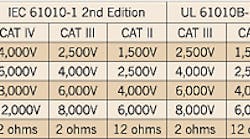Using a properly rated test instrument on your next project can mean the difference between completing the task without incident or suffering a serious injury
According to the U.S. Bureau of Labor Statistics, 329 electrical workers died on the job between 1992 and 1998. Of those, 68 were electrocuted after coming into direct contact with electrical equipment. With this in mind, it's become increasingly important to use test instruments that provide the highest levels of protection.
Test instruments that meet the requirements of IEC standard 61010-1 and the U.S. standards based on it, such as UL 61010B-1 and C22.2 No. 1010.1, provide transient protection levels far greater than the instrument's maximum rated input. This type of protection wasn't required in instruments designed to older standards like IEC 348 and UL 1244. Using a test instrument without this additional protection against transient overvoltages can result in serious injury or death.
CAT I-rated test instruments are signal-level tools for telecommunications and electronic equipment. Transient voltage risk is limited, but still exists, due to the distances between equipment locations and other equipment located between it and the primary electrical supply. The IEC no longer specifies protection levels for CAT I instruments. Under UL 3111-1, a Cat I 150V rated instrument must be protected to 800V. Under IEC 61010-1 2nd edition, a Cat I 150V meter could be protected only to 500V, as long as that information is in the user's manual.
CAT II-rated test instruments cover the local level of circuits for fixed or non-fixed power devices. This includes most lighting equipment, appliances, and 120V or 240V equipment inside a building.
CAT III-rated test instruments can withstand the transient voltage range found on most distribution circuits. These instruments are used primarily on fixed primary feeders or branch circuits. They're separated from CAT IV utility service or other high-voltage source equipment by at least one level or through transformer isolation.
CAT IV-rated test instruments are designed for testing on the primary supply source, which also includes 120V or 240V overhead or underground lines that power detached buildings or underground lines that power well pumps. The CAT IV rating covers the highest and most dangerous level of transient overvoltage electricians encounter when working on utility service equipment like exterior transformers.
Latest UL standards.
The latest UL standard for electrical test instruments is UL 61010B-1, which is a revision of 3111-1. It specifies the general safety requirements, such as material, design, and testing requirements, and the environmental conditions in which the standard applies. UL 3111-2-031 lists additional requirements for test probes. The requirements for hand-held current clamps, such as the current measuring portion of clamp meters, are included in UL 3111-2-032.
UL standards are gradually being harmonized with similar international standards, such as those published by IEC. Until this is completed, there may be significant differences between each group's standards. For example, IEC 61010-1 2nd Edition includes requirements for voltage-measuring instruments in CAT IV environments. UL 61010B-1 doesn't.
Making safe measurements.
Before making a measurement, review the basics. Have you selected the proper instrument for the task at hand? In other words, does the test instrument have the necessary features and provide an appropriate level of overvoltage protection? The voltage and current ratings should be clearly marked on the meter.
Review the meter's instruction manual, and set the selector for the proper function. This helps to avoid incorrect readings and damage to the meter — or you. Always test the instrument on a known live circuit before performing the test on the unknown circuit. Look for the mark of a nationally recognized testing lab, such as UL or CSA, on the meter. This mark ensures a third party has properly tested the product. A CE rating doesn't guarantee that an independent lab evaluated the instrument for compliance to safety standards. Don't forget about test leads or other accessories. Their category and voltage ratings are also important to user safety.
Striving for safety.
As the industry continues its quest to keep electricians safe, new standards and test instruments designed with safety and convenience in mind continue to help make that possible. In support of this goal, measurement category ratings continue to exceed the minimum UL requirements, thus giving you peace of mind when testing on an energized system.
Ellis is senior product manager for Greenlee, a Textron company, in Rockford, Ill.



